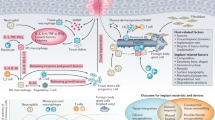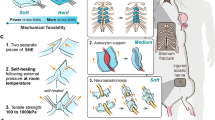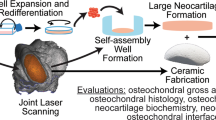Abstract
Implants for the treatment of tissue defects should mimic the mechanical properties of the native tissue of interest and should be resorbable as well as biocompatible. In this work, we developed a scaffold from variants of poly(glycolic) acid which were braided and coated with an elastomer of poly(glycolide-co-caprolactone) and crosslinked. The coating of the scaffold with the elastomer led to higher mechanical strength in terms of compression, expansion and elasticity compared to braids without the elastomer coating. These composite scaffolds were found to have expansion properties similar to metallic stents, utilizing materials which are typically much weaker than metal. We optimized the mechanical properties of the implant by tuning the elastomer branching structure, crosslink density, and molecular weight. The scaffolds were shown to be highly resorbable following implantation in a porcine femoral artery. Biocompatibility was studied in vivo in an ovine model by implanting the scaffolds into femoral arteries. The scaffolds were able to support an expanded open lumen over 12 months in vivo and also fully resorbed by 18 months in the ovine model.
This is a preview of subscription content, access via your institution
Access options
Access Nature and 54 other Nature Portfolio journals
Get Nature+, our best-value online-access subscription
$29.99 / 30 days
cancel any time
Subscribe to this journal
Receive 12 print issues and online access
$259.00 per year
only $21.58 per issue
Buy this article
- Purchase on Springer Link
- Instant access to full article PDF
Prices may be subject to local taxes which are calculated during checkout






Similar content being viewed by others
References
Nishio, S. et al. Long-term (>10 years) clinical outcomes of first-in-human biodegradable poly-l-lactic acid coronary stents: Igaki–Tamai stents. Circulation 125, 2343–2353 (2012).
Bunger, C. M. et al. Sirolimus-eluting biodegradable poly-L-lactide stent for peripheral vascular application: a preliminary study in porcine carotid arteries. J. Surg. Res. 139, 77–82 (2007).
Uurto, I. et al. Drug-eluting biodegradable poly-D/L-lactic acid vascular stents: an experimental pilot study. J. Endovasc. Ther. 12, 371–379 (2005).
Onuma, Y. et al. Three-year results of clinical follow-up after a bioresorbable everolimus-eluting scaffold in patients with de novo coronary artery disease: the ABSORB trial. EuroIntervention 6, 447–453 (2010).
Alexy, R. D. & Levi, D. S. Materials and manufacturing technologies available for production of a pediatric bioabsorbable stent. Biomed. Res. Int. 2013, 137958 (2013).
Scheinert, D. et al. Prevalence and clinical impact of stent fractures after femoropopliteal stenting. J. Am. Coll. Cardiol. 45, 312–315 (2005).
van der Giessen, W. J. et al. Marked inflammatory sequelae to implantation of biodegradable and nonbiodegradable polymers in porcine coronary arteries. Circulation 94, 1690–1697 (1996).
Lincoff, A. M. et al. Sustained local delivery of dexamethasone by a novel intravascular eluting stent to prevent restenosis in the porcine coronary injury model. J. Am. Coll. Cardiol. 29, 808–816 (1997).
Fischell, T. A. Polymer coatings for stents. Can we judge a stent by its cover? Circulation 94, 1494–1495 (1996).
Venkatraman, S., Boey, F. & Lao, L. L. Implanted cardiovascular polymers: natural, synthetic and bio-inspired. Prog. Polym. Sci. 33, 853–874 (2008).
Vogt, F. et al. Long-term assessment of a novel biodegradable paclitaxel-eluting coronary polylactide stent. Eur. Heart J. 25, 1330–1340 (2004).
LACTEL Absorbable Polymers. Chemical & Physical Properties of Select Polymers (cited May 26, 2014); http://www.absorbables.com/technical/properties.html
Nuutinen, J. P. et al. Mechanical properties and in vitro degradation of bioresorbable knitted stents. J. Biomater. Sci. Polym. Ed. 13, 1313–1323 (2002).
Chen, M. C. et al. Rapidly self-expandable polymeric stents with a shape-memory property. Biomacromolecules 8, 2774–2780 (2007).
Nuutinen, J. P. et al. Mechanical properties and in vitro degradation of bioabsorbable self-expanding braided stents. J. Biomater. Sci. Polym. Ed. 14, 255–266 (2003).
Pulapura, S. & Kohn, J. Trends in the development of bioresorbable polymers for medical applications. J. Biomater. Appl. 6, 216–250 (1992).
Chen, C. C. et al. Preparation and characterization of biodegradable PLA polymeric blends. Biomaterials 24, 1167–1173 (2003).
Vert, M. et al. Bioresorbability and biocompatibility of aliphatic polyesters. J. Mater. Sci. Mater. Med. 3, 432–446 (1992).
Orchel, A. et al. Growth of human chondrocytes on biodegradable synthetic polymers. Acta Pol. Pharm. 63, 455–456 (2006).
Wise, D. L. Biomaterials and Bioengineering Handbook (CRC Press, 2001).
Juan, V. C.-R. et al. Advances in Biomaterials Science and Biomedical Applications Ch. 3: Degradation of Polyurethanes for Cardiovascular Applications (InTech, 2013).
Dalene, M., Skarping, G. & Brorson, T. Chromatographic determination of amines in biological fluids with special reference to the biological monitoring of isocyanates and amines. IV. Determination of 1,6-hexamethylenediamine in human urine using capillary gas chromatography and selective ion monitoring. J. Chromatogr. 516, 405–413 (1990).
Dalene, M., Skarping, G. & Tinnerberg, H. Biological monitoring of hexamethylene diisocyanate by determination of 1,6-hexamethylene diamine as the trifluoroethyl chloroformate derivative using capillary gas chromatography with thermoionic and selective-ion monitoring. J. Chromatogr. B. Biomed. Appl. 656, 319–328 (1994).
Serruys, P. W. et al. Incidence of restenosis after successful coronary angioplasty: a time-related phenomenon. A quantitative angiographic study in 342 consecutive patients at 1, 2, 3, and 4 months. Circulation 77, 361–371 (1988).
Leigh Perkins, L. E. Preclinical models of restenosis and their application in the evaluation of drug-eluting stent systems. Vet. Pathol. 47, 58–76 (2010).
Acknowledgements
We thank J. Anderson, R. Virmani, R. Schwartz, and S. Hilbert for consultation and feedback. We acknowledge the efforts of A. Pappas, T. Ng, K. Ho, I. Gitlin, P. Zamiri, W. Naimark, A. Rago, D. Sundaresh, J. Marini, S. Morneau, M. Le, S. Varughese and K. Un in device fabrication, data collection, analytical evaluation, and manuscript review.
Author information
Authors and Affiliations
Contributions
U.S., D.C., L.C., Y.K., C.Y., G.Z., R.B., S.W. and M.P. conceived the experiments. C.Y. and J.M. performed the experiments. U.S., D.C., L.C., Y.K., C.Y., Q.P., G.Z. R.B. and S.W. undertook analysis of the data and results. U.S., D.C., L.C., Y.K., C.Y, Q.P., R.L. and G.M.W. wrote the manuscript.
Corresponding author
Ethics declarations
Competing interests
Upma Sharma PhD, Danny Concagh MS, Lee Core MSE, Yina Kuang PhD, Changcheng You PhD, Quynh Pham PhD, Greg Zugates PhD, Rany Busold BS, Jonathan Merlo BS, Stephanie Webber BS and Maria Palasis PhD were employees of 480 Biomedical at the time of this work. All authors have stock options in 480 Biomedical.
Supplementary information
Supplementary Information
Supplementary Information (PDF 431 kb)
Rights and permissions
About this article
Cite this article
Sharma, U., Concagh, D., Core, L. et al. The development of bioresorbable composite polymeric implants with high mechanical strength. Nature Mater 17, 96–103 (2018). https://doi.org/10.1038/nmat5016
Received:
Accepted:
Published:
Issue Date:
DOI: https://doi.org/10.1038/nmat5016
This article is cited by
-
4D printed hydrogel scaffold with swelling-stiffening properties and programmable deformation for minimally invasive implantation
Nature Communications (2024)
-
Particle Distribution Informed by Chain Rigidity in Diblock Copolymer Melts: The Effect of Entropy
Chinese Journal of Polymer Science (2024)
-
Highly Elastic, Bioresorbable Polymeric Materials for Stretchable, Transient Electronic Systems
Nano-Micro Letters (2024)
-
Mechanical, Free Vibration and Modal Damping Behaviour of Treated Rice Bran Green Composite for 3D Printing Application Using RSM and Design of Experiment Method
Journal of Vibration Engineering & Technologies (2023)
-
Development of sand-plastic composites as floor tiles using silica sand and recycled thermoplastics: a sustainable approach for cleaner production
Scientific Reports (2022)



